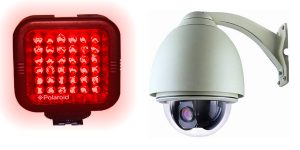In some cases CCTV cameras are used to monitor a space only for the daytime. Such instances do not require any special camera. But in most other circumstances the requirement for the CCTV camera is to monitor for both Day and Night. Such requirements are fulfilled by using a Day/Night camera with Infrared (IR) illuminator.
There are two types of Day/Night cameras. One of them uses internal IR LEDs which means that the IR lights or LEDs are placed on the camera, generally in circles around the camera lens. The other type of night vision camera uses a separate IR illuminator that is placed alongside the camera. Both of these forms of Day/Night cameras have their own advantages and disadvantages. Some of them are discussed below.
Internal IR Cameras
Cost-efficient: As the IR LEDs are installed on the camera, these cameras do not require extra hardware for Infrared Lights. You can simply connect the cameras as you do for the Day only cameras and it starts recording. This also saves you considerable amount of time.
Enhanced IR solutions: Overexposure to IR light can be an issue with IR cameras. Therefore many camera manufacturers are producing smart cameras that adapt to the intensity of the IR radiation so that there are no overexposure and the picture is clear.
Easy setup and configuration: When the IR LEDs are integrated with the camera, only one power source is enough to meet the energy requirement of both the camera and the LEDs. This reduces wiring and is simple to install. Also, since the LEDs are built-in, controlling the LEDs and camera is easy and can be managed through the DVR/NVR interface.
No dark spots: The inbuilt IR LEDs in these night vision cameras come with out-of-the-box IR spread that matches the horizontal and vertical angle of view. This makes sure that the illumination is even and there are no dark spots when the IR is switched on.
Costly Replacement: In the event of damage of some or all of the LEDs the entire camera have to be replaced. This becomes expensive even if in the short run internal IR cameras are less costly than external IR cameras.
Insects: The IR LEDs also generate heat which attracts insects like spiders. Often these insects obstructs the camera lens and also triggers false motion alarms. In addition to these, the insects can also cause overexposure by reflecting radiation falling on their bodies onto the camera lens.
 External IR Cameras
External IR Cameras
Flexible choice: With external LEDs you can place them anywhere giving you complete flexibility of choice for installing the cameras and LEDs as you like.
No Obstruction: Since the LEDs are placed at a separate distance from the cameras, the insects are attracted to the LED panel and not the cameras. This gives complete view of the monitored space without obstruction or overexposure.
Costly installation: The extra hardware required for LEDs makes these cameras costlier than the internal IR Cameras at the start.
Labour: These cameras also require more time to install and adjust properly to get the maximum out of the camera.
